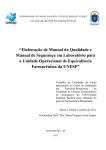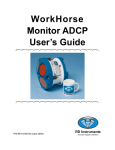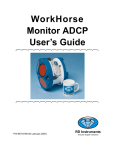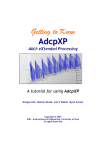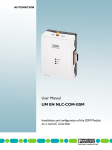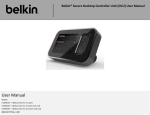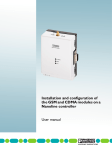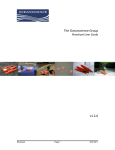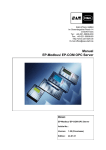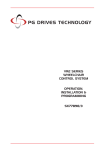Download procedures for review and approval of ADCP discharge
Transcript
PROCEDURES FOR THE REVIEW AND APPROVAL OF ADCP DISCHARGE MEASUREMENTS First Edition Water Survey of Canada Meteorological Service of Canada Environment Canada Ottawa, Canada, 2004 Canada Procedures for the Review and Approval of ADCP Discharge Measurements First Edition Revision History Revision 0.0 Date April 2004 Source DCG/FOG Description/Rational for Change First Edition Abstract This publication describes procedures required for conducting the quality assurance and quality control of discharge measurements performed using RDI ADCPs and WinRiver software version 10.06. This is one of several documents defining the standard procedures to be followed by ADCP Operators and Quality Assurance Data Reviewers. As such, it is intended to be used by Water Survey of Canada personnel only after the completion of an introductory level ADCP training course and in conjunction with the documents called “Policy on the Use of Hydro-Acoustic Technologies in Water Survey of Canada Operations”, “Procedures for Conducting ADCP Discharge Measurements” and “Procedures for the Accreditation of ADCP Operators”. Foreword The Procedures for the Review and Approval of ADCP Discharge Measurements were prepared to assist Water Survey of Canada personnel within the Meteorological Service of Environment Canada. These procedures serve to validate hydrometric data. Since hydro-acoustic technology in general and the techniques required for deploying an ADCP are still evolving rapidly, this document is expected to require frequent updates. In addition, it should be noted that at this stage ADCP hydro-acoustic sampling equipment is expected to evolve and since many elements within these procedures remain software and product specific, it is expected that the relevance of this document will be limited to current practices. Acknowledgement It is not possible to acknowledge the specific contribution of each individual whose help was invaluable in completing this document. We offer many thanks to members of the Field Operations Group and the Data Control Group within Water Survey of Canada Division of Environment Canada. This document draws heavily on procedures drafted by the Hydro-Acoustic Working Group of the United States Geological Survey. In addition, references from ADCP manufacturers were instrumental in ensuring that all information provided was accurate. SOP002-2004 2 Procedures for the Review and Approval of ADCP Discharge Measurements First Edition TABLE OF CONTENTS Abstract .................................................................................................................................................................................... 2 Foreword .................................................................................................................................................................................. 2 Acknowledgement.................................................................................................................................................................... 2 1.1 Roles and Responsibilities:............................................................................................................................................ 5 1.2 General Processes:......................................................................................................................................................... 5 2.0 Review of Site Characteristics and Set-up ........................................................................................................................ 6 2.0.1 Data Archival:......................................................................................................................................................... 6 2.0.2 ADCP Survey Notes: ............................................................................................................................................... 6 2.0.3 Naming Convention:................................................................................................................................................ 6 2.0.4 Personnel Certification: .......................................................................................................................................... 6 2.0.5 Equipment Maintenance:......................................................................................................................................... 6 2.0.6 Equipment Suitability: ............................................................................................................................................. 7 2.0.7 Temperature Record:............................................................................................................................................... 7 2.0.8 Salinity Record:....................................................................................................................................................... 7 2.0.9 Diagnostics Tests: ................................................................................................................................................... 7 2.0.10 Compass Calibration: ........................................................................................................................................... 7 2.0.11 Moving Bed Test:................................................................................................................................................... 7 3.0 Review of Transects .......................................................................................................................................................... 8 3.1 Configuration ................................................................................................................................................................ 8 3.1.1 Commands ............................................................................................................................................................... 8 3.1.2 Offsets...................................................................................................................................................................... 8 3.1.3 Processing ............................................................................................................................................................... 8 3.1.4 Discharge ................................................................................................................................................................ 9 3.1.5 Edge Estimates ........................................................................................................................................................ 9 3.2 General Review ............................................................................................................................................................. 9 3.2.1 Bad Ensembles ........................................................................................................................................................ 9 3.2.2 Lost Ensembles ........................................................................................................................................................ 9 3.2.3 Bad Bins .................................................................................................................................................................. 9 3.2.4 Measured Q ............................................................................................................................................................. 9 3.2.5 Shore Discharge .................................................................................................................................................... 10 3.2.6 Temperature .......................................................................................................................................................... 10 3.2.7 Ship Track ............................................................................................................................................................. 10 3.2.8 Ambiguity Velocities.............................................................................................................................................. 10 3.2.9 GPS Quality........................................................................................................................................................... 11 3.2.10 Unusual Data Features ....................................................................................................................................... 12 3.2.11 Valid Bins at Edges ............................................................................................................................................. 12 3.2.12 Boat Speed........................................................................................................................................................... 12 3.2.13 Pitch and Roll...................................................................................................................................................... 14 3.3 Trends.......................................................................................................................................................................... 14 3.3.1 Extrapolation Techniques...................................................................................................................................... 14 3.4 Corrections .................................................................................................................................................................. 15 3.4.1 File Sub-section..................................................................................................................................................... 15 3.4.2 Reference ............................................................................................................................................................... 15 3.4.3 Offsets.................................................................................................................................................................... 16 ADCP Transducer ...................................................................................................................................................... 16 Compass ..................................................................................................................................................................... 16 3.4.4 Processing ............................................................................................................................................................. 16 Speed of Sound ........................................................................................................................................................... 16 Data Screening ........................................................................................................................................................... 16 Thresholds .................................................................................................................................................................. 16 3.4.5 Discharge .............................................................................................................................................................. 17 Parameters ................................................................................................................................................................. 17 Cut Water Profiles Bins.............................................................................................................................................. 17 Shore .......................................................................................................................................................................... 17 3.4.6 Edge Estimates ...................................................................................................................................................... 17 SOP002-2004 3 Procedures for the Review and Approval of ADCP Discharge Measurements First Edition 4.0 Review of Measurement.................................................................................................................................................. 17 4.0.1 Deviation from Average ........................................................................................................................................ 17 4.0.2 Number of Transects Used .................................................................................................................................... 17 4.0.3 Reciprocal Pairs.................................................................................................................................................... 17 4.0.4 Overall Results Consistency .................................................................................................................................. 18 4.0.5 Justification for Discarded Transects.................................................................................................................... 18 5.0 Data Packaging and Archiving........................................................................................................................................ 18 5.1 Packaging .................................................................................................................................................................... 18 5.3 Archiving..................................................................................................................................................................... 18 Appendix A: ADCP General Transect Review Quick Sheet.................................................................................................. 21 Appendix B: Standards and Guidelines.................................................................................................................................. 22 Appendix C: File Naming Conventions for ADCP Measurement Data ................................................................................. 24 Appendix D: ADCP Measurement Review Notes.................................................................................................................. 25 Bibliography........................................................................................................................................................................... 27 SOP002-2004 4 Procedures for the Review and Approval of ADCP Discharge Measurements First Edition 1.0 Introduction This document is a reference and summary guide of the minimum requirements for reviewing ADCP measurements. It is not intended as a replacement for training. It describes the measurement review procedures for data quality assurance by ADCP Operators and Quality Assurance Data Reviewers. The review of a measurement at this level results in the determination of whether or not an ADCP measurement is valid. There are 4 elements of ADCP measurement review procedures detailed in this document: Review of site characteristics and set-up, Review of transects, Review of measurement, Data packaging and archiving. These review procedures should also be used with the following documentation: 1. Data files produced during the measurement visit (diagnostic, calibration and moving bed tests, transects); 2. Accepted version of the WinRiver software, 3. ADCP Survey Notes (form R21A-05/03) 4. ADCP Measurement Review Notes (form F002-2004) 5. ADCP Maintenance History (form F001-2004) The reviewers should check the WSC intranet site to ensure that approved procedures and software are current. 1.1 Roles and Responsibilities: Only qualified personnel should review discharge measurements. It should be done as soon as practical after the measurement was conducted. It is important to clearly define the accountability for the data review. The following are suggestions for defining these roles in your area: Responsibilities of ADCP Operators The ADCP Operators have the responsibility to maintain their own qualifications. They must ensure that each ADCP measurement they conduct meets field quality assurance objectives as defined in Procedures for Conducting ADCP Discharge Measurements. They must ensure that the equipment is well maintained and in good working order. The Operators must also perform the first review of the measurement based on the procedures outlined in this document before to submit it to a Quality Assurance Data Reviewer. Responsibilities of Quality Assurance Data Reviewers The Quality Assurance Data Reviewers have the responsibility to maintain their qualifications. They must ensure that criteria outlined in these procedures as well as in the Procedures for Conducting ADCP Discharge Measurements are met to produce the valid discharge measurement value. They are also responsible to ensure that all documentation pertaining to the production of this post-processed discharge measurement value is properly archived at the sub-office level and that the data is ingested in the databases. 1.2 General Processes: The general processes to post-process and quality assess an ADCP measurement is as follows: • The ADCP Operator must have performed a preliminary review while in the field to ensure that enough data of adequate quality will be available to produce a measurement value. • Back in the office, the ADCP Operator stores the raw data and ADCP Survey Notes in Short Term Archive. • The ADCP Operator follows the procedures outlined in this document to produce a first draft of postprocessed discharge measurement value. Using the ADCP Measurement Review Notes (Appendix D), the pertinent review information is tracked down. The raw files and Survey Notes are not modified. The review results are saved and a draft summary of the discharge measurement is produced with the Q Measurement Wizard (*.dmw). • The Quality Assurance Data Reviewer obtains the information pertaining to the ADCP measurement from the ADCP Operator. Using information from the ADCP Measurement Review Notes, the Reviewer follows SOP002-2004 5 Procedures for the Review and Approval of ADCP Discharge Measurements • First Edition the procedures outlined in this document a second time to evaluate and add to the conclusions made during the first review. This second review should be done in cooperation with the ADCP Operator whenever necessary. Any additional and pertinent information identified by the Reviewer is also tracked down on the Review Notes. The final quality assessed transect configurations are locked and saved and a final summary of the discharge measurement is again produced with the Q Measurement Wizard (*.dmw), printed and saved. All files produced during the measurement and the review are then stored in the Short Term Archive at the office level. The final discharge measurement value (as per the Q Measurement Wizard summary file *.dmw) has now been quality assessed and can be used if valid. Figure 1: General flow of ADCP files during the review Operator QA Officer QA Raw files (*r.000; *n.000; *d.000; *w.000) Short Term Archive Survey Notes CompuMod Review Changes: *w.00# Q Measurement: *.dm# Review Notes Review Changes: *w.00# Q Measurement: *.dm# Review Notes 2.0 Review of Site Characteristics and Set-up Review the following: 2.0.1 Data Archival: Check that data has been properly stored in Short Term Archives, including adequate folder structure. See subsection 5.2 for details. 2.0.2 ADCP Survey Notes: Review the field notes (form R21A-05/03) to ensure that they are complete. Refer to the Procedures for Conducting ADCP Discharge Measurements for details. 2.0.3 Naming Convention: Check that proper file names were used. Refer to Appendix C for details about the file naming conventions. 2.0.4 Personnel Certification: Confirm that personnel who conducted the measurement and the review are properly certified. Refer to the Procedures for ADCP Operator Accreditation for details. 2.0.5 Equipment Maintenance: Check the ADCP maintenance history to ensure that routine and annual instrument checks were done. This includes firmware updates. Refer to the Procedures for Conducting ADCP Discharge Measurements, subsection 2.1 for details. SOP002-2004 6 Procedures for the Review and Approval of ADCP Discharge Measurements First Edition 2.0.6 Equipment Suitability: Based on site characteristics identified on the ADCP Survey Notes, assess if the right equipment was used. 2.0.7 Temperature Record: Check that water temperature was measured and recorded by thermometer near the ADCP face prior to the measurement. 2.0.8 Salinity Record: Check that the surface salinity was measured and recorded if work was conducted in areas with potential saltwater intrusions, such as estuaries. Otherwise, WinRiver should be set to Use ADCP Value which is 0 for fresh water. 2.0.9 Diagnostics Tests: Open the diagnostic test files and check the following: Confirm that the latest version of the diagnostic test was used. PS0 command – check that the ADCP Maintenance History and Survey Notes are consistent with the PS0 data on model, frequency, serial number, and firmware. PC1, PC2, PA commands – check that all the tests indicate ‘pass’. If not, refer to the ADCP user manual to determine the potential severity of the problem. 2.0.10 Compass Calibration: Check that the ADCP compass was calibrated, as required for the type of deployment. Calibrating the compass is essential when using a GPS and highly recommended when not. Assess the validity of the value used as local magnetic variation. 2.0.11 Moving Bed Test: A moving bed test must be performed prior to every discharge measurement, even when GPS is used. Bottom Track provides the highest accuracy and should be used whenever no moving bed is detected. Testing for moving bed can be avoided only if it is confirmed and documented that this phenomena does not exist at that site for the conditions encountered and should be noted as such. Review the moving bed test conclusions using the test files and the ADCP Survey Notes: a. Play back the moving bed test. The file should display at least 10 minutes of recording with the boat stationary at a location where moving bed is expected. b. Examine the ship track with bottom track as reference for any upstream movement of the boat. Take into account the method used to maintain the boat in steady position and possible errors influencing this method (e.g., result are reliable if a boat is anchored at a test site while bottom track displays an upstream motion). If GPS is available, look at the Combo Ship Track and determine if the bottom track trajectory ends up upstream from the GPS trajectory. c. Record the amount of perceived upstream displacement. Note the Distance MG from the Composite Tabular. Make sure that this value does not represent a displacement that is not upstream (e.g., drift sideways). If GPS is available, note the bottom track distance made good less the GPS distance made good (BMG-GMG mag) as shown in the Compass Calibration Tabular. The compass must be properly calibrated and an accurate magnetic variation must be used for this value to precisely represent the position bias created by the moving bed. d. From the Composite Tabular, record the Time taken to complete the test. e. Note the Flow Speed from the Discharge History Tabular (F12). This is an estimate of the average velocity in the vertical at the test site. f. Estimate the moving bed velocity by dividing the perceived upstream displacement by the total test time. g. Estimate the bias error caused by the moving bed by dividing the moving bed velocity with the test site Flow Speed. SOP002-2004 7 Procedures for the Review and Approval of ADCP Discharge Measurements First Edition h. The moving bed is considered significant if there is: i.) perceived upstream displacement in the ADCP position referenced by bottom track while the same displacement cannot exist in the earth reference system; and ii.) estimated bias error above 1% (moving bed velocity / test site mean velocity > 0.01). i. Compare the review conclusions with those made while in the field. Check that adequate mitigation measures were adopted. If a moving bed was observed, then GPS is required as reference to obtain an accurate measurement. See sub-section 3.2.9 to assess if the GPS quality is adequate. Without quality GPS and if no alternative measurement technology could be used, at least 3 moving bed tests spread evenly across the river must have been performed to estimate the discharge bias. j. If the final Reviewer considers that the quality of data produced by estimating the moving bed bias is acceptable, a comment relative to the correction method must be documented in the Review Notes, the final discharge summary file (.dmw) and ultimately in the database. Write “Estimated Moving Bed bias” in the general comments section of the Review Notes. See section 5.0 for details on the packaging of data. 3.0 Review of Transects Continue the measurement review by assessing each individual transect. Check the parameters described below and document your findings in the Review Notes. If you find that some settings or parameters are not appropriate, note the changes to be made and reasons for it in the Review Notes. Start WinRiver in Playback mode. Under Settings, make sure that Units are set to the metric system (SI). Review each transect for the following: 3.1 Configuration Examine the equipment and configuration used to produce transects, as detailed in the Ensemble Header Tabular (F9). Information from this table will help you know the deployment approach adopted for each specific transect. While changes between transects are acceptable, it is good practice to produce all transects in the same manner. Review the Configuration Settings (F3). In tabs, look at: 3.1.1 Commands Assess that the modes and commands used were well suited to the site conditions described on the Survey Notes. Investigate any User Commands entered, if any, to make sure that their use was appropriate (Refer to the ADCP user manuals for details on configuration commands and their application). ADCP Operators should only use the Configuration Wizard to program an ADCP. Commands cannot be corrected during post-processing. 3.1.2 Offsets Check that the ADCP Depth and Compass Mag Variation are adequate and in line with the Survey Notes. If not, enter correct values. 3.1.3 Processing Check that water tracking does not Use 3 Beam Solution in WinRiver. Use only 4 beam solutions for water tracking. Accepting solutions produced with only 3 beams will not ensure that the assumption of homogeneous flow applies. However, using 3 beam solutions is desirable for Bottom Tracking. Check if the Thresholds values are the initial configuration ones (*w.000) or if they were modified during any previous review. Changes to the values and the reasons for it must be documented in the Review form. You can revert to initial values by right clicking on it with your mouse. See section 3.4 for details on changing thresholds. SOP002-2004 8 Procedures for the Review and Approval of ADCP Discharge Measurements First Edition 3.1.4 Discharge If doing the very first review, check that Top and Bottom Discharge Methods are set to Power with a Coefficient of 1/6. If the value used is different, justification for the change must be documented in the Review form. If not, adjust it back to the method stated above. Trends in data will be assessed in subsection 3.3. Check that Shore Left and Shore Right Bank Edge Types are consistent with the Survey Notes. If not, enter correct values. 3.1.5 Edge Estimates Check that Begin and End Shore Distances are consistent with the ADCP Survey Notes. If not, enter correct values. 3.2 General Review During the general review, transect files must be played back without averaging or sub-sectioning. Under Settings, go to File Subsection (F6) and Select All Ensembles. If the file had been sub-sectioned, values can be reset later with information documented about it in the Review Notes. Then, go to User Options (F7) and set the Number of Ensembles to Average to 1. Play back the entire file to the end (End). Note: To interpret velocity contours, it is useful to choose the average flow angle as the projection angle for viewing the data on screen. This is done by pressing F2. It is also useful to adjust the color legends to use data minimum and maximum values as a start. To do this, right click on any view to edit its Properties. Then select the desired option under Contour Legends. Under Composite Tabular (F11 to swap), review the following: 3.2.1 Bad Ensembles Calculate the ratio of bad ensembles over the total number of ensembles in the file (Bad Ens./# Ens.). There should be less than 10% bad ensembles in good transects. If the percentage is too high, try to identify what caused it. Consider rejecting a transect if missing information is not randomly spread and large stretches of data are missing. 3.2.2 Lost Ensembles Calculate the ratio of lost ensembles over the total number of ensembles in the file (Lost Ens./# Ens.). There should be less than 10% lost ensembles in good transects. If the percentage is too high, try to identify what caused it. Consider rejecting a transect if missing information is not randomly spread and large stretches of data are missing. 3.2.3 Bad Bins The percentage of bad bins (% Bad Bins) should be less than 25%. If the percentage is too high, try to identify what caused it. Consider rejecting a transect if missing information is not randomly spread and large stretches of data are missing. 3.2.4 Measured Q Calculate the percentage of measured discharge over the total discharge (Measured Q/Total Q). More than 50% of the discharge should be measured and not estimated. If the percentage is too low, try to identify what caused it. Examine the cross section shape to assess the transect validity. For example, the proportion of Q that is measured versus estimated may be smaller for shallow rivers but it might still adequately represent flow conditions. It may not be the case for rivers with very large edges. SOP002-2004 9 Procedures for the Review and Approval of ADCP Discharge Measurements First Edition 3.2.5 Shore Discharge Note any negative discharge. It might indicate an incorrect starting bank. Look at the ADCP Survey Notes to take into account actual site conditions. To correct the start bank, see Shore in section 3.4. 3.2.6 Temperature Check that ADCP temperature probe values are consistent with the value measured with a thermometer. An ADCP should be checked if a difference larger than 5oC between its temperature probe and the value measured by thermometer persists throughout the measurement. Under Stick Ship Track, review the following: 3.2.7 Ship Track Check the ship track. A good transect should have a relatively straight path. A twisted path might be the sign of internal compass problems. This is sometimes also caused by the presence of ferrous material near the ADCP. If there are zigzags or loops on the ends of the track, these might have to be sub-sectioned. If judged necessary, see File Sub-section in section 3.4. 3.2.8 Ambiguity Velocities Left click once on the Stick Ship Track view to select it. Using the down arrow, change the depth of data displayed from surface to bottom. Note the presence of any velocity vector for which the magnitude is much higher and the direction does not agree with the general flow in the area. See figure 2. These are the signs of ambiguity velocities. If ambiguity velocities are suspected, it is possible to screen them out to a degree. To do so, refer to Thresholds in section 3.4. Figure 2: Ambiguity velocities in the Stick Ship Track SOP002-2004 10 Procedures for the Review and Approval of ADCP Discharge Measurements First Edition Under Combo Ship Track, GPS Tabular and Compass Calibration Tabular, review the following: 3.2.9 GPS Quality If GPS was available during the deployment, check the Combo Ship Track to see if the GGA track and Bottom Track diverge. Determine if there are irregularities in the GGA track when compared to the Bottom Track. The two tracks should be similar. If not, this might be a sign of poor GPS quality, but it could also be caused by a bad compass calibration, an incorrect magnetic variation, the presence of ferrous material aboard or a moving bed affecting the data. See figure 3, 4 and 5 for examples. Try to identify the source of the difference. Review the compass calibration files to determine how successful it was. Check the value used for magnetic variation and modify it if required. Review the conclusions of the moving bed test. In the GPS Tabular view, the value for HDOP should remain under 4 and the Delta Altitude should be less than 3.5 m during a transect in order to have quality GPS. Too many changes of satellite constellation is another source of error with GPS and the number of such changes should be monitored as an indicator of quality (Sats Changes in GPS Tabular). The fewer changes there are, the better the data should be. Figure 3: Diverging GGA and Bottom Track caused by a moving bed bias. Figure 4: Suspect quality for GPS as can be observed in Stick Ship Track, Combo Ship Track and GPS Tabular. While nothing peculiar is seen in the Stick Ship Track with Btm as reference, position errors caused by satellite constellation and type of correction changes create spikes in the measured velocity when using GGA as reference. SOP002-2004 11 Procedures for the Review and Approval of ADCP Discharge Measurements First Edition Figure 5: Reciprocal transects with internal magnetic compass problems caused by ferrous material on the boat. These transects should look the same but the compass is only affected when going from the left to the right shore. Under Projected Velocity Contour & Error Velocity Contour, review the following: 3.2.10 Unusual Data Features Note the presence of unusual features such as gaps, vertical stripes, spikes, etc. The validity of transects with too many unusual data features might be dubious. Document your observations and conclusions in the Review Form. Gaps might indicate a loss of bottom tracking. Check if bottom track is continuous or if it has large sectors missing. See figure 6. Loss of bottom tracking can be caused by rapid change in depth or boulders on the bed. Allowing the use of 3 beam solutions is desirable for bottom tracking. Vertical stripes in the Error Velocity Contour may indicate the presence of ambiguity velocities. In the Error Velocity Contour, errors should be randomly distributed. See figure 7. Spikes might indicate configuration errors. Assess the modes used and in particular the use of any command not entered through the Configuration Wizard. Other examples of unusual features include schools of fish interfering with signals or eddies created by bridge piers if the measurement is taken downstream from a bridge. See figure 8. Both create shadow like shapes in the velocity contour. Experience of field conditions and in the use of other contour plots such as Backscatter, Intensity or Correlation will potentially help identify the reasons for any peculiar data. While some errors can be screened out during post-processing, problems with data is best avoided during the recording and through careful site selection. 3.2.11 Valid Bins at Edges Check for at least 2 valid bins near the edges. These are required to produce a valid characterization of the velocity profile near the edges using the nearest 10 ensembles to estimate edge discharge. If required, adjust edges by sub-sectioning. See File Sub-section in section 3.4. Under Boat Speed Time Series & Water Speed Time Series, review the following: 3.2.12 Boat Speed Check that the boat was at rest near the edges to help characterize the velocity profile in those areas. Also, check that the boat moved at a speed slower than the water and was affected by as little acceleration as possible. SOP002-2004 12 Procedures for the Review and Approval of ADCP Discharge Measurements First Edition Figure 6: Loss of Bottom Track caused by abrupt change of depth Figure 7: Error Velocity Contour showing random error distribution Figure 8: Pier eddies visible in the Velocity Magnitude Contour SOP002-2004 13 Procedures for the Review and Approval of ADCP Discharge Measurements First Edition Under Pitch and Roll Time Series, review the following: 3.2.13 Pitch and Roll Check that pitch and roll angles remain as close to zero as possible and less than 5 degrees on average. High variation in pitch and roll angles might be caused by surface chop. High pitch angles might be produced under high water velocity conditions as the boat steps up. See figure 9. Such conditions are less than adequate for making a measurement and should be avoided through site selection. The validity of transects with too much pitch or roll might be dubious. Figure 9: Extreme pitch and roll angles during tethered boat deployment in very fast waters 3.3 Trends To identify any trend in a transect, average ensembles during the review. Under User Options (F7), set the Number of Ensembles to Average between 10 and 20, depending on the cross-section shape to have similar ensemble depths averaged together. Try choosing a number so that ensembles with approximately the same depth are averaged. Then, slowly play (F4) the transect several times while looking for trends. Under Discharge Profile, review the following: 3.3.1 Extrapolation Techniques Check that the measured data profile compares well to the power fit curve. The measured discharge data and the power fit curve should be similar if power fit is the correct extrapolation technique. See figure 10. If it deviates, assess if it is at random or not. If not random, there are two likely possibilities. 1) Current in the upper layers might be influenced by high winds. Look at the Survey Notes for any information about such conditions. 2) Current in the bottom layers might be influenced by reversed flow, a situation usually seen in tidal areas. To factor in such trends, assess and select by trial and errors the best alternative to the power fit method to use for top and bottom discharge methods. For trends at the top, try either a constant or 3 point slope method. For trends at the bottom, try the no slip method. See figure 11 for both methods. Never use the constant method for bottom data. Such adjustment to top and bottom estimation methods is transect specific as site conditions may quickly change over the time of the measurement. Note your conclusions in the Review form. SOP002-2004 14 Procedures for the Review and Approval of ADCP Discharge Measurements Figure 10: Discharge data similar to power fit curve First Edition Figure 11: No slip bottom extrapolation and 3 points slope top extrapolation methods Once the review of trends is complete, reset the Number of Ensembles to Average back to 1. 3.4 Corrections For transect problems identified in previous steps, various post-processing corrections can be used. In general, a parameter can be changed by right clicking on the value once to then pick either Edit or Edit and Freeze on the displayed menu. Edit will change settings for the opened transect only while Edit and Freeze will change the settings for the opened transect and all subsequent transects that will be reviewed. The following sub-sections describe specific correction possibilities and methods: 3.4.1 File Sub-section A file length can be reduced by rejecting ensembles at either end. To do so, select File Sub-section under Settings, tick off Select All Ensembles and enter the preferred First Ensemble Number and Last Ensemble Number. Make sure that the edge distances are still accurate after modifying a file. Review the Survey Notes to determine if the sub-sectioned distance should be added to or subtracted from the distance to shore. If it should, note the distance made good prior to any sub-sectioning. Then, playback the file after modifying its end and note the new distance made good. The difference between the entire file and the modified file is positive if the new end is further away from shore and negative if closer to shore. Correct the Shore Distance under Edge Estimates with this value if appropriate. See figure 12. Repeat the process if subsectioning is required for the other file end. 3.4.2 Reference Select the reference best suited to the measurement conditions under Settings and Reference. Two reference systems can be used to determine the relative position of ADCP data during a discharge measurement: bottom track which computes position relative to the river bed, and GPS which computes position relative satellites. Bottom track is preferable when there is no significant moving bed observed. SOP002-2004 15 Procedures for the Review and Approval of ADCP Discharge Measurements First Edition Figure 12: Correction of shore distance during file sub-sectioning Initial Distance Made Good Shore Sub-sectioned Distance New Distance Made Good 3.4.3 Offsets ADCP Transducer Under Configuration Settings and Offsets, the ADCP Transducer Depth can be adjusted to the correct value. Compass Under Configuration Settings and Offsets, the Magnetic Variation and other compass parameters can be adjusted to the correct values. 3.4.4 Processing Speed of Sound The calculation for the Speed of Sound can be chosen to best suit site conditions. The speed of sound is influenced by temperature and salinity. For computing river discharge values, Use ADCP Value suits most conditions. This may no longer be adequate when the salinity is above zero. See WinRiver help file on Processing for details on other options. Data Screening These features are used to select data to consider within the computations. In particular, selecting the Use 3 Beam Solution for WT would allow solutions not considered suitable for water velocities and is therefore not the standard. Thresholds Under Configuration Settings and Processing, it is possible to adjust the thresholds values to screen out bad data. These thresholds are the error velocities, the up velocities and the fish intensity. If the ADCP raw data exceeds the specified threshold, the particular data is flagged as bad and not considered in the computation. To rid data of ambiguity velocities, lower the water tracking error velocity (WT Error Vel) by increments until most suspect velocities disappear. Note the percentage of bad bins and other data quality indicators before and after each attempt. Suspect velocity spikes may never disappear as they may be part of real velocity features. The same method of investigation applies to the use of the fish intensity threshold to clean data from fish interferences. See figure 2 for an example where ambiguity velocities were screened out. Lowering the up velocity threshold might also work to filter out suspect velocity spikes since flow should only go horizontally. But doing so might rid data of real features specific to the site and should therefore be avoided. Using thresholds to improve the data quality cannot replace good configuration and site selection. It is only a last resort compromise. SOP002-2004 16 Procedures for the Review and Approval of ADCP Discharge Measurements First Edition 3.4.5 Discharge Parameters The top or bottom discharge method can be modified under Configuration Settings and Discharge. For the discharge method, it is preferable to analyze and edit each transect specifically. Never choose Constant as a method for the bottom discharge. Cut Water Profiles Bins This feature makes it possible to reject bins below the blanking distance or above the side lobe distance prescribed by the configuration. With this feature, it might be possible to salvage transects in which the blanking distance was set too short for the equipment used. Enter the number of suspect bins to be rejected. Shore The edge discharge estimation method can be adjusted under Configuration Settings and Discharge. 3.4.6 Edge Estimates Starting edge and shore distances can be corrected under Configuration Settings and Edge Estimates. Remember to document in the Review form every correction made to a file and the reasons why such correction was deemed necessary. Save and lock each transect configuration file. 4.0 Review of Measurement The final value of an ADCP discharge measurement is the average of 4 valid transects or more. Once the review of the individual transects is complete and corrections are applied, evaluate the measurement overall quality by combining the valid transects together. Select the valid transects that should contribute to the final discharge value and play them back until they are all listed in the Discharge History Tabular (F12). Disregard any unwanted transect such as false starts or other files with critical problems, as documented in the Review Notes. In the Discharge History Tabular, delete any file or clear the table by left clicking twice on any file name. Then, review the overall measurement for the following: 4.0.1 Deviation from Average Check that all transects’ Total Q’s are within 5% of the average. In the Discharge History Tabular, text in black indicates that a transect is within 5% of the average. If any text is red, it indicates that this transect is not within 5% of the average. Try to identify the reason for any transect not within 5% of the average. It may be that some corrections were not made, such as a wrong starting bank, transducer depth, shore distance, etc. It might be that the stage was rapidly changing during the measurement. 4.0.2 Number of Transects Used The final discharge measurement value is the average of at least 4 valid transects, including outliers if there is no reason to reject them, but not including invalid transects. If the initial 4 transects were not within 5% of the average and no reason could explain it, an additional 4 transects must have been obtained while in the field. Under these circumstances, the final discharge measurement is the average of up to 8 valid transects, including outliers if there is no reason to reject them, but not including invalid transects. 4.0.3 Reciprocal Pairs Starting banks should not all be the same but should instead form reciprocal pairs. In other words, there should be as many transects going one way across the river than the other. Reciprocal pairs reduce bias SOP002-2004 17 Procedures for the Review and Approval of ADCP Discharge Measurements First Edition errors caused by the difference in flow as perceived by the instrument when crossing the river in opposite directions. 4.0.4 Overall Results Consistency Check that left and right shore distances, left and right discharge estimates, area, width, boat and water speed and direction is consistent between all transects. In other words, all transects should be similar. 4.0.5 Justification for Discarded Transects Acceptable justification must be produced and documented in order to discard a transect. Discarded transect must display critical data problem. Note any additional change made during this section in the Review Notes. Again, make sure that transect configuration files are locked and saved. 5.0 Data Packaging and Archiving Once the measurement has been quality assessed, it can be packaged and archived. 5.1 Packaging In WinRiver, enter the Q Measurement Wizard (Ctrl+Q). Using the Survey Notes and the Review Notes, complete the front page of the Q Measurement Wizard. The discharge measurement summary that it produces (.dmw file and printed report) will be used to enter results within the Water Survey of Canada databases. It is therefore important to properly fill the Q Measurement Wizard front page. Table 1 and Figure 13 describe the data to be entered on that page. If there was a significant moving bed effect but the discharge data could only be produced by estimating the bias from 3 or more moving bed tests (No GPS could be deployed), remember to document it. Write “Estimated Moving Bed bias” in the General Comments section of the Review Notes and in the Remarks section of the Q Measurement Wizard. Select all valid transects that constitute the measurement. Print the discharge summary and save the Wizard file as Station#_Date.dmw (If only 1 discharge measurement was made at the site that day, the default extension .dmw should remain unchanged. However, if more than one measurement was done for the station on that day, the extension is modified to .dm# where # is a sequential number that specifies which measurement done on the site that day is in the file.). 5.3 Archiving The following is a list of files that constitute an ADCP measurement and which must be archived together: Diagnostic Self-test diagnostic *.txt files Calibration Text files for AF & AX calibration tests of magnetic compass. Raw ADCP data related to calibration (*r.000, *w.000, *n.000, etc.) Moving bed test Raw ADCP data related to test (*r.000, *w.000, *n.000, etc.) Transects Raw ADCP data for each Transect ( *r.000, *w.000, *n.000, etc.) SOP002-2004 18 Procedures for the Review and Approval of ADCP Discharge Measurements First Edition Discharge measurement Final and locked configuration files for each reviewed Transect, including transects considered not valid (*w.00#) Q Measurement Wizard file summarizing the measurement (*.dmw) both electronically and on paper ADCP Survey Notes (form R21A-05/03) ADCP Measurement Review Notes (form F002-2004) Establish a system for the Short Term Archive and the storage of ADCP data produced in your area: 1. Data should be backed up while in the field. ADCP Operators should carry memory cards to regularly mirror data stored in the field laptop computer. 2. Allocate space on an office server that is routinely backed up. 3. Create a directory structure consistent with file naming and previous filing conventions. 4. Transfer data from the field laptop to the office server right away. 5. Ensure that the ADCP data is periodically stored in the Water Survey of Canada long term archives as part of the routine and regular Raw Data backups. Table 1: Description of data that must be entered in the Q Measurement Wizard Field A B C G H I J U V W X Z Name Station Number Station Name Party Date of Measurement Measurement Number ADCP Serial Number Inside Gage Height Water Temp. Diagnostic Test Filename Moving Bed Test Filename Compass Calibration Filename Remarks SOP002-2004 Notes Write the initials of ADCP Operators. Write the measurement number if more than 1 was done at the station that day. Enter the Correct M.G.H here Measured by thermometer Enter the name of the first test file. Write the number of diagnostic tests in Remarks if more than 1 exists. Enter the name of the first test file. Write “Estimated Moving Bed bias” in the Remarks if there was moving bed, no GPS could be used and the discharge value was estimated using 3 or more moving bed tests. Write the number of moving bed tests in Remarks if more than 1 exists. Enter the name of the first test file. Write the number of calibration tests in Remarks if more than 1 exists. Write “Estimated Moving Bed bias” if there was moving bed, no GPS could be used and the discharge value was estimated using 3 or more moving bed tests. Write the number of any test if more than 1 of the same kind exists. 19 Procedures for the Review and Approval of ADCP Discharge Measurements First Edition Figure 13: Location of Data to enter in the Q Measurement Wizard (* marks essential data) SOP002-2004 20 Procedures for the Review and Approval of ADCP Discharge Measurements First Edition Appendix A: ADCP General Transect Review Quick Sheet FURTHER INVESTIGATE ANY ITEM FOR WHICH THE ANSWER TO THE QUESTION IS NEGATIVE. Open ADCP Raw Data File (Ctrl+O) to select the desired file. Start taking notes on the ADCP Data Review Progress form. Step 1 – Computation Attributes Review info on Ensemble Header Tabular (F9) to get a first idea about the transect deployment approach. Review Configuration Settings (F3). In tabs, look at: Commands: User Commands field empty? (i.e. User Commands) Offsets: ADCP Depth and Compass Mag Variation correct? Processing: Use 3 Beam Solution clicked off for WT? Thresholds at *w.000 values? Shore Discharge: Top/Bottom Discharge Methods at Power with Coefficient 1/6? Shore Left/Right Bank Edge Types consistent with Survey Notes? Edge Estimates: Begin/End Shore Distances consistent with Survey Notes? Moving Bed Test: Are test results negative? Step 2 – General Review File Subsection (F6), note values, then Select All Ensembles. Playback entire file (End). Load Projection Angle (F2). Composite Tabular (F11 Swap) % Bad Ensembles (Bad Ens./# Ens.)<10%? % Lost Ensembles (Lost Ens./# Ens.)<10% ? % Bad Bins < 25%? Measured Q/Total Q > 0.5? Temperature within 5o of Thermometer? Stick Ship Track Trajectory relatively straight? Absence of potential ambiguity velocities (Use ↓)? Combo Ship Track Is GPS quality adequate if it is required? Projected Velocity Contour & Error Velocity Contour Absence of gaps or unusual features? Continuous bottom track? 2 valid bins near edges? Boat Speed Time Series & Water Speed Time Series Boat at rest near start/end points? Boat slower than water? Boat displays little acceleration? Pitch and Roll Time Series Angles remain small? Step 3 – Trends Under User Options (F7), set the Number of Ensembles to Average between 10 and 20. Play (F4) the Transect several times while assessing the following: Discharge Profile top/bottom extrapolation follow the power fit curve well? Under User Options (F7), reset the Number of Ensembles to Average back to 1. Step 4 – Correction Open Next ADCP Raw File (F5) to repeat the process Once all Transects are reviewed, proceed with corrections identified as required during previous steps. Save and lock the Configuration File. Step 5 – Discharge Display the Discharge History Tabular (F12) and erase all unwanted Transects (double click name to erase or clear table). Are all Total Q’s for valid transects within 5% of the average? Do Start Banks alternate to form reciprocal pairs? Are Left/Right Dist., Left/Right Q, Area, Width, Boat Speed, Flow Dir. and Duration consistent? Packaging Data Enter Q Measurement Wizard (Ctrl+Q) Using ADCP Survey Notes and ADCP Measurement Review Notes, complete the front page of the Q Measurement Wizard. Select Transects which are part of the measurement. Print a copy. Save as Station#_yyyymmdd.dmw (replace w by the measurement number if more than 1 Q value was produced at the site that day.). SOP002-2004 21 Procedures for the Review and Approval of ADCP Discharge Measurements First Edition Appendix B: Standards and Guidelines The process to deploy ADCPs and the knowledge of what constitute the good data from this technology is still evolving. For the time being, the following standards and guidelines will be used to assess the quality of Acoustic Doppler Current Profiler measurements. Standards ADCP Depth: The ADCP depth, or vertical distance between the water surface and the centre of the transducer faces, must be measured to within 1 cm. Correlation The correlation of water velocities must be done using 4 beam solutions. Diagnostic Test: The instrument must be subjected to and pass the most complete instrument check routine available prior to every discharge measurement. Discharge Computation: Discharge must be the average of at least two pairs of reciprocal transects (4 transects) within 5% of their average. Two additional pairs of reciprocal transects must be obtained when the two pairs are not within 5% of their average and no critical problem can be identified and documented for the difference. Under such conditions, once transects are validated, the discharge measurement becomes the average of up to 8 transects. Discarding and replacing a transect can be done only if a critical problem is identified and documented for it. e.g., False start. Extrapolation Method Top and Bottom: The discharge extrapolation method for velocities near the surface and the bed must be “power” with 1/6 as exponent. The use of any other method must be demonstrated and documented during data review. Edges: 10 ensembles must be used at the transect start/end points to extrapolate velocity data toward the edges. Magnetic Variation: The internal ADCP compass must be calibrated when using a GPS. It is good practice to do it before each measurement. An accurate value for the local magnetic declination must be used when using a GPS. Moving Bed: A moving bed test must be performed prior to every discharge measurement. During a moving bed test, the ADCP must record data in steady position for at least 10 minutes. Performing a moving bed test can be avoided only if it was confirmed and documented that this phenomena does not exist at the site for conditions encountered. The moving bed effect is considered significant when there is perceived upstream displacement of the boat and the ratio of “moving bed velocity” versus “test site mean velocity” is greater than 0.01. When a significant moving bed is detected, differential GPS must be used to compute boat velocities. If it is not possible to use a differential GPS, an alternative discharge measurement method should be used. Otherwise, at least 3 moving bed tests spread evenly across the river must be performed. If the quality of data produced by estimating the bias from a moving bed effect is deemed acceptable by Reviewers, a comment relative to the correction method must be documented. SOP002-2004 22 Procedures for the Review and Approval of ADCP Discharge Measurements First Edition Ensembles: Ensembles must be averaged outside of the ADCP. Only single water pings must be used to produce ensembles, with exception for specialized modes designed to operate differently. No more than 2 bottom pings can be used to produce ensembles. Salinity: Water salinity can be set to 0 when working in fresh water environments. It must be measured when working in estuaries or anywhere with potential saltwater intrusions. Software Version: Only an officially accepted version of WinRiver can be used to produce discharge measurements. Temperature: Water temperature must be measured with a thermometer near the ADCP prior to each discharge measurement. Time: The ADCP time must be set to clock prior to every discharge measurement. Guidelines Boat speed: Boat speed should not exceed water speed during a measurement. Above all, what is important is to have a smooth boat operation with as little acceleration as possible. Edge Integrity: To prevent side-lobe interference and other acoustic contamination from vertical channel walls, start/stop points of transects must be no closer to a wall than the depth of water near that wall. (e.g., if the depth at the vertical wall is 4 m, the transects should start/stop no closer than 4 m to the wall). Ensembles closest to the edge should contain at least 2 valid bins. Transect Quality: Transects should have less than 10% bad ensembles and 10% lost ensembles Transects should have less than 25% bad bins Transects should have a ratio of Measured/Total Discharge greater than ½. Factors influencing the measurement such as the shape of the cross section must be considered while assessing the quality of a transect based on these guidelines. Pitch and Roll: The average pitch and roll angles should be less than 5o throughout a transect. Temperature: An ADCP should be checked if a difference larger than 5oC persists between the ADCP temperature probe and the value measured by thermometer during the measurement. GPS Quality: The trajectory defined by GPS should contain no large irregularities (large drifts and spikes) and, overall, be similar to the one defined by Bottom Track, within the errors caused by a potential moving bed effect. HDOP should be less than 4. Delta Altitude should remain less than 3.5 m. SOP002-2004 23 Procedures for the Review and Approval of ADCP Discharge Measurements First Edition Appendix C: File Naming Conventions for ADCP Measurement Data The Acoustic Doppler Current Profiler (ADCP) is being introduced to the Water Survey of Canada as a new technology for obtaining river discharge. This instrument is capable of producing large amounts of data across numerous files. It has been agreed that as a new technology all files used and produced by the ADCP in the course of obtaining a discharge measurement will be retained. This includes calibration and configuration data as well as generated measurement data. The following proposed naming conventions would ensure that all ADCP data is stored systematically and in a manner that is nationally consistent with existing conventions. MMM TRANSECT number. This number starts at 000 and increments each time you stop and then start data collection. The maximum number of transects is 999. NNN x r w n d t h File sequences number. This number starts at 000 and increments when the file size reaches the user-specified limit (set in Settings menu, Configuration Settings, Recording tab). File type (assigned during data collection or playback) Raw ADCP data. Copy of the configuration file created during Acquire mode. Navigation GPS data. Depth Sounder data. ASCII-out data (This convention is the default for ASCII-out data, but you can use other names and extensions.) External heading device data file. Hardware diagnostic data file StationNo._yyyymmdd_tst.txt Raw configuration data file Raw transect data file Raw navigation data file Raw depth sounder data file Output ASCII data file External heading device data file Compass calibration data file StationNo._yyyymmdd_MMMw.NNN StationNo._yyyymmdd_MMMr.NNN StationNo._yyyymmdd_MMMn.NNN StationNo._yyyymmdd_MMMd.NNN StationNo._yyyymmdd_MMMt.NNN StationNo._yyyymmdd_MMMh.NNN Magnetic declination data file Moving bed test data file Discharge measurement data file StationNo._yyyymmdd_magdMMMr.NNN StationNo._yyyymmdd_mbedMMMr.NNN StationNo._yyyymmdd.dmw StationNo._yyyymmdd_ccal.txt Multiple tests are to be appended to this file Multiple tests are to be appended to this file Change w in .dmw to #, a sequential number starting at 1 to identify the measurement if more than one measurement was taken at the site that day. Example: 02KB001_20020906_003r.000 Measurement taken at station 02KB001 on September 6, 2002; “003” indicates that it is the third transect; “r” indicates that it is an ADCP raw data file. File Naming Exception: Please note that if more than one team is taking more than one measurement at a site on the same day, remove the date from the filename prefix and introduce a date and time stamp with WinRiver. This date and time stamp is set in WinRiver under Configuration Settings (F3), Recording tab where you can select the option Add Date/Time to the Filename. SOP002-2004 24 Procedures for the Review and Approval of ADCP Discharge Measurements First Edition Appendix D: ADCP Measurement Review Notes Station name: Measurement No. : _____________________________ Section 1: Review of Site Characteristics and Set-up Adequate Review Item Y/N Data Archival Station No.: Date: Comments ADCP Survey Notes Naming Convention Personnel Certification Equipment Maintenance Equipment Suitability Temperature Record Salinity Record Diagnostics Test Compass Calibration Moving Bed Test Section 2: Review of Transects – Indicate approval with a tick mark. Add comments in Section 3. Transect # Configuration Commands Offsets Processing Discharge Edge Estimates General Review Bad Ensembles Lost Ensembles Bad Bins Measured Q Shore Discharge Temperature Boat Trajectory Ambiguity Velocities GPS Quality Unusual Data Features Valid Bins at Edges Boat Speed Pitch and Roll Trends Extrapolation Techniques FOR002-2004 . . Procedures for the Review and Approval of ADCP Discharge Measurements Trans. # First Edition Section 3: Review of Transects – Comments and Changes Made Section 4: Review of Measurement Deviation from Average Number of Transects Used Reciprocal Pairs Overall Results Consistency Discarded Transects Justification Adequate (Y/N) Adequate (Y/N) Adequate (Y/N) Adequate (Y/N) Adequate (Y/N) General Comments ADCP Operator:____________________________________________Date:_____________ Time Spent on Review: ______PY Reviewer:_________________________________________________ Date:_____________ Time Spent on Review: ______PY FOR002-2004 Procedures for the Review and Approval of ADCP Discharge Measurements First Edition Bibliography Bowden, Clare, Murray Jones, and Greg MacCulloch, 2002, Process Requirements for Developing Positioning Specification, Submission to the Field Operations Group, Environment Canada. Hydro-Acoustic Working Group, 2002, Quality Assurance Plan for Discharge Measurements Using ADCP’s - Draft,. USGS. Lipscomb, Stephen, 1995, Quality Assurance Plan for Discharge Measurements Using Broadband ADCP’s, USGS Report 95-701. MoC-WS, 2003, Policy on the Use of Hydro-Acoustic Technologies in Water Survey of Canada Operations, February 11, 2003, Environment Canada. Mueller, David, Field Assessment of Acoustic-Doppler Based Discharge Measurements, USGS. Mueller, David, Use of ADCP’s for Measuring Discharge in Streams with Appreciable Sediment Transport, USGS. NovAtel, OEM4 Family of Receivers, Volume 1 - Installation & Operation Manual (OM-20000046), Volume 2 Command and Log Reference Manual (OM-20000047), Rev. 11, January 30, 2003. ABX-3/MBX-3 Reference Manual, CSI Wireless, August 1998 Oberg, Kevin, Easy-to-Use Methods for Calibrating ADCP’s For Velocity and Discharge Measurements, USGS. Office of Surface Water Technical Memorandum No. 2002.01, Configuration of Acoustic Profilers (RD Instruments) for Measurement of Streamflow, Dec 7, 2001. Rainville, Francois, 2004, ADCP Technical Note – Testing for Moving Bed and the use of a threshold value, Draft. Water Survey of Canada, Environment Canada. Ramin, Vida and Jeff Woodward, 2003, ADCP Technical Note – Requirements for In-field Salinity Measurements as Part of Hydro-acoustic Technology Deployments. Water Survey of Canada, Environment Canada. RD Instruments, 1996, Acoustic Doppler Current Profiler. Principles of Operation - A Practical Primer, Second Edition for Broadband ADCPs. Simpson, M.R., 2002, Discharge Measurements Using a Broad-Band Acoustic Doppler Current Profiler. U.S. Geological Survey Open-file Report 01-01. Water Survey of Canada, 2004, Procedures for Conducting ADCP Discharge Measurements, Version 1.0. Environment Canada. Water Survey of Canada, 2004, Procedures for the Accreditation of ADCP Operators, Version 1.0, 2004, Environment Canada. Woodward, Jeff, 2003, A Water Survey Division Policy for the Use of RDI Acoustic Doppler Current Profilers within the Prairie and Northern Region, Policy Version 1.0. Woodward, Jeff, Deborah Folk, 2003, A Water Survey Division Quality Control and Quality Assurance Policy for Obtaining Discharge Measurements using RDI Acoustic Doppler Current Profilers, Version 2.0.



























